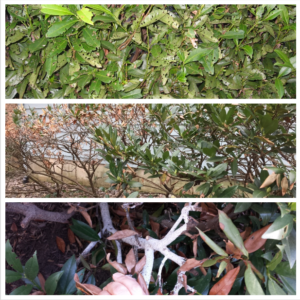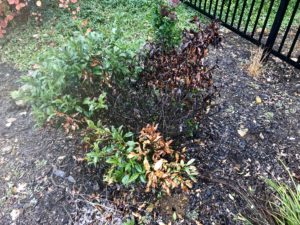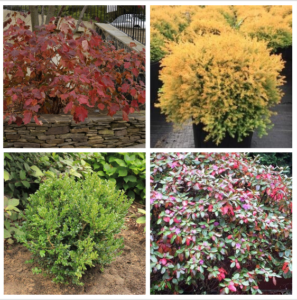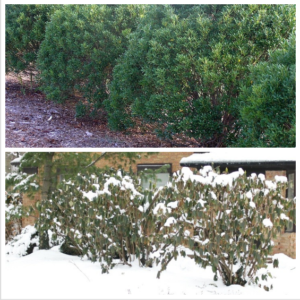A flowering evergreen shrub that likes full sun is a bit of a unicorn in our region. Numerous ‘wonder shrubs’ have been marketed into favor only to fail in the landscape. Cold Hardy Camellia & Gardenia we find are not so hardy and fall short of their marketed promise. Even Japanese Hollies (Ilex crenata) have permanently crossed themselves off of savvy designer’s lists due to their poor & short performance in the landscape. The need for this type shrub has given rise to another unsustainable and perpetually problematic shrub. The newest mania… Cherry Laruel aka ‘Otto Luyken’ & ‘Schip’ Laurels. Landscapers commonly encounter this plant not only at the residential level but on the commercial one as well. Local growers struggle to produce quality plants in the nursery in our region and often time must buy the plants in from the West Coast or states south of us just to have a salable plant. The market demand is high at the moment, as is the need to replace these shrubs that continuously fail in the landscape. This is good for garden centers because everyone has to keep buying the same plant over and over. It is a predictable cycle of disappointment. They truly are the Leyland Cypress of the shrub world without a doubt.
These Laurels are prone to root rot and susceptible to fungal problems in our area. Some of these diseases are nothing more than a perpetual annoyance while others can severely damage the shrub and kill it. Leaf spots are caused by fungus that attacks the shrub, causing wilting, curling and premature dropping of foliage. Bacterial leaf blight, similar to leaf spot, is very common and has absolutely no chemical control. Phytophthora fungi attacks the crown and roots of Cherry Laurel shrubs, causing various damaging symptoms such as wilted, stunted and discolored foliage that drops from the stems. This also very common problem has no chemical control and will kill the shrub as well. Shothole fungus, while not life threatening can be a very annoying and unattractive problem with these plants on an annual basis. Powdery Mildew & Aphids infestations are also very common. These problems spread from plant to plant and often times take out an entire hedge. We truly are left scratching our heads as to why this plant is still so popular. We went so far as to plant one here at Windridge to track it’s progress. It was a very healthy plant, and one of the few that was raised locally. The shrub was left over from a project and we decided to turn it into an experiment. It has been in our landscape for three years now. It has put on little to no growth and is showing signs of fungal dieback. We anticipate its removal by Spring of 2020 at the latest.
Laurel at our shop
Consider planting Inkberry, Osmanthus, shrub form Arborvitaes, False Cypress, Globe Cryptomeria, Grey Owl Juniper, or a Blight Tolerant Boxwood like ‘Green Beauty’. Consider a semi evergreen like several of our viburnums such as ‘Conoy’ or Leatherleaf , Oakleaf Hydrangeas, or perhaps PJM Rhododendron in a semi protected partially shaded area. Even ornamental grasses can offer a visual buffer over the winter & provide habitat for native pollinators.
Upper Left Oakleaf, Lower Left Green Beauty, Upper Right Rheingold Arborvitae, Lower Right PJM Rhododendron
There is not one obvious substitute plant for this situation. We are working with both our residential & commercial clients to find sustainable & diverse substitutes. To wrap this up do yourself a favor and scratch Otto Luyken & Schip Laurel off your list permanently.
Upper Inkberry Hedge, Lower Leatherleaf Hedge in Winter








